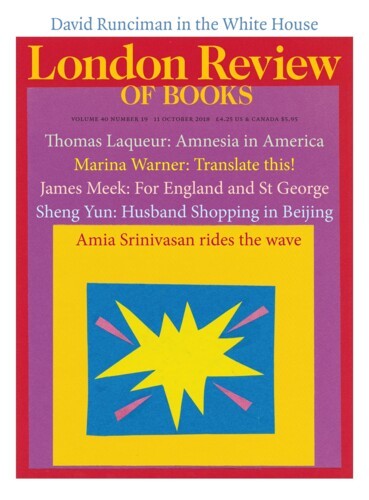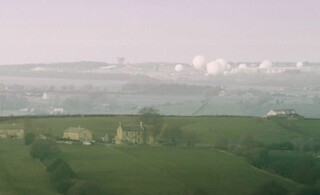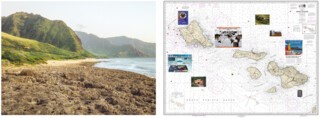How should a visual artist respond to a culture in which the vast majority of images are produced by machines for other machines, with humans left out of the loop? This technological turn complicates basic ideas about mimesis: that images represent the world, that they are meant to be beheld by us, that they mean at all (think of facial-recognition programs alone). The standard critique that contemporary society is swamped by spectacle, by images directed at us, may also have to be revised. If power today depends largely on data – on invisible information harvested, searched, surveilled and acted on by corporations, governments, insurance companies, credit agencies and police departments – how are we to track it, let alone challenge it?
These are a few of the questions that motivate Trevor Paglen, an American artist based in Berlin. A geographer by training, Paglen was struck by the heavy redactions of aerial photographs from the US Geological Survey that he uncovered after the start of the Iraq War; they impelled him to fill in the blank spots on the maps, to register the black sites somehow. Thus Limit Telephotography (2005-present), his series of photographs of remote surveillance systems and clandestine military operations taken with high-powered lenses usually at a great distance (as far as sixty miles away) and often on land difficult to access. (Paglen regards the very shooting of these secret locations as a political act: ‘To take a photograph is to insist on the right to take a photograph.’) However immaterial or concealed they are, security networks, extraordinary renditions and the like all require physical infrastructure – satellites, receivers, cables, server stations, administrative buildings, holding pens, airplanes, hangars, towers and strips. Yet Paglen does not reveal much of this. Instead his images play on a disconnect that we are prompted to suture as best we can: we behold a beautiful abstraction in hazy strips of pastel colours from sand pink to sky blue, and then read the caption ‘Chemical and Biological Weapons Proving Ground/ Dugway, UT/Distance approx. 42 miles/ 11.17 a.m.’; or we take in a semi-pastoral scene titled English Landscape, and then notice a weird array of white globes in the background identified as ‘American Surveillance Base near Harrogate, Yorkshire’. Paglen admits that the photographs, a streaky blur in the first case and a near mirage in the second, are ‘useless as evidence’, but his aim is different: to show how secrecy is produced as a set of limitations on what is seeable, representable and knowable. For Jacques Rancière the fundamental stake of politics is the ‘distribution of the sensible’; for Paglen contemporary power has entered into a quasi-sublime condition: the ‘fading of the sensible’.
In his next series, The Other Night Sky (2007-present), Paglen swung from the horizontal orientation of the landscape to the vertical axis of the heavens. With information culled from official government documents as well as amateur satellite watchers, he trained his high-powered lenses, now set on computer-controlled mounts to adjust for the rotation of the Earth, on the orbital paths of surveillance satellites, which appear as faint streaks across his dark prints. (As in the first line of Thomas Pynchon’s Gravity’s Rainbow, ‘a screaming comes across the sky,’ only here the screaming is silent.) Apart from intelligence-gathering in the present, the satellites are also space debris of the future, even eventual artefacts of an extinct humankind (those in a frictionless orbit will remain for ever). Other images are designed to evoke the 19th-century survey photos of the American West by Timothy O’Sullivan and others. In this analogy between ‘reconnaissance’ on the frontier then and in space now, Paglen implies that landscape as a genre is rarely innocent, that it often masks acts of violence, dispossession, disaster and death. One difference, he remarks, is that ‘the other night sky’ has ‘closed the temporal loop between surveying, ordering and targeting’.
Surveillance comes for us by sea as well as by land and air, and in the wake of Edward Snowden’s leak of National Security Agency documents, Paglen turned to this domain. In two series, titled Cable Landing Sites and Undersea Cables (both 2015-16), he aimed his camera at ‘choke points’ where physical bits of the security network are known to exist but can rarely be seen. Each work in Cable Landing Sites is a diptych juxtaposing a photo of an otherwise banal shoreline with a nautical chart of the area collaged with information from the Snowden files and other sources, while each image in Undersea Cables shows a murky sea bottom with a section of tube that looks like marine junk. Here, as the curator John Jacob points out in his excellent essay in the Smithsonian publication, Paglen works against the obfuscation of terms like ‘cyberspace’ and ‘the cloud’; in his own words, Paglen aims to ‘rematerialise the network’ and thereby ‘to expand the visual vocabulary we use to “see” the US intelligence community’.
This aspect of his ‘experimental geography’ draws on the precedent of the ‘site-nonsite’ artwork of Robert Smithson in order to respond to Fredric Jameson’s call for a ‘cognitive mapping’ of advanced capitalism. In the process Paglen also suggests a model of photography that turns the influential account of Roland Barthes on its head: rather than the inadvertent detail that charges the image almost accidentally (which Barthes called the punctum), Paglen photographs intentional objects that are almost hidden from view – in the distant background in Limit Telephotography, in the blue yonder in The Other Night Sky, and on the shore and sea floor in the Cable series. With regard to 89 Landscapes (2015), a two-channel video of other choke points that Paglen made while working as a cameraman for Citizenfour, Laura Poitras’s film about Snowden, he refers to these scenes as ‘the picturesque of the Terror State’. This is a difficult, perhaps impossible, project. As Jacob puts it, Paglen does not expose secrets so much as he shows secrecy at work, not only in remote compounds and classified spacecraft but also at extra-legal sites and ‘outside-inside spaces’ (Guantánamo Bay is only the most famous one); he shows them as near abstractions that nonetheless point to an entire system of capital, intelligence-gathering and control. In front of these images we do not see so much as we believe, or rather, in seeing a little we are edged into believing a lot – a mode of viewing that is ‘critical-paranoid’ (I mean this term positively, as Philip K. Dick did when he defined the paranoiac as a person hell-bent on the truth).
In the mid-19th century a French painter might remove any evidence of industrial production from his beautiful landscapes, while his American counterpart might work to assimilate the ‘machine in the garden’ as a brave sign of national progress. By the early 20th century, however, a ‘second nature’ of man-made structures had come to overlay the natural world in ways that could not be obviated or absorbed. And today, as Alexander Kluge has suggested, we face a ‘third nature’, a world not only produced by machines but also run through networks largely beyond our perception, let alone our mastery. ‘If the public sphere, the arts, the relationship to people no longer grows with the complexity of society as a whole,’ Kluge warns, ‘then third nature arises.’
In one recent attempt to convey this complexity Paglen has taken the all too useful devices of the surveillance regime and rendered them useless. His Nonfunctional Satellites and Orbital Reflectors (2013-present) are prototypes, cast in pure geometries out of beautiful metals, which shift these objects from commercial and military service and towards visual and aesthetic wonder: Malevich in the Sky with Diamonds. If a satellite can become an artwork, in a corollary move an artwork might be turned into a device. Paglen created his Autonomy Cube (2015), set in a Plexiglas box in a gallery or museum, as an open wifi hub run over the free Tor network, which was designed to anonymise communication. Here the art space is momentarily transformed into a safe space removed from corporate-state oversight (has the fabled public sphere come to this grim point?), and ‘autonomy’ is defined less as Kantian ‘purposiveness without purpose’ than as a brief hiatus from ‘algorithmic citizenship’ (as the artist and writer James Bridle refers to our profiling by FAANG, aka Facebook, Apple, Amazon, Netflix and Google).
In his earlier work Paglen approached the security apparatus from afar; in his recent projects he attempts to get inside its mechanisms. In this he follows the lead of the late German filmmaker Harun Farocki, who, according to Paglen, ‘entered the sound stages, editing rooms, post-production houses and techno-military laboratories’ in order ‘to show humans how a machine is seeing’ (or, more precisely, scanning). Where Paglen once evoked what secrecy looks like, now he takes up images that normally we cannot see at all, images made by machines for other machines. Typically we believe that visual devices have enabled perception, as the chronophotography of Muybridge and Marey once revealed the mechanics of motion; that they extend our vision prosthetically; that they can even open up new realms such as the ‘optical unconscious’ proclaimed by Walter Benjamin in the 1930s. Today, however, machines often not only do the seeing for us but also act on the patterns they detect. Hence the advent of ‘operational images’ that ‘intervene in everyday life’, as Paglen puts it, images that have shifted in purpose from representation to activation. Operational images are invisible, he continues; ‘machines rarely even bother making the meat-eye interpretable versions of their operational images.’ Once a figment of sci-fi fantasy, the dreaded ‘singularity’ – whereby technology absorbs and surpasses human capabilities – has already begun to reach us. Automated licence plate readers in the streets and motion-tracking systems in the stores are routine, as is the searching and collating of Facebook entries by advertisers, creditors, insurers, tax officials and cops. Paglen tells us that Facebook is fed two billion images a day, from which it gleans ‘places and objects, habits and preferences, race, class and gender identifications, economic statuses and much more’. In this way ‘capital searches out new domains of everyday life to bring into its sphere,’ as do security agencies of many kinds.
Thus for Paglen the imperative is not only to show humans how a machine reads but also ‘to unlearn how to see like humans’: ‘we need to learn how to see a parallel universe composed of activations, keypoints, eigenfaces, feature transforms, classifiers, training sets and the like.’ His video installation Behold These Glorious Times! (2017) is a first lesson in this long re-education; here Paglen paired hundreds of thousands of images used in computer-vision experiments with the representations of an AI program as it learned to recognise faces and expressions as well as objects and actions. He has also produced composite portraits out of ‘facial signatures’, the unique attributes of a face registered by biometric recognition software. Such programs are used in security systems, of course, but also on digital platforms (Facebook reports 97 per cent accuracy of identification with its DeepFace algorithm). Paglen describes these techniques as ‘immensely powerful levers of social regulation that serve specific race and class interests’, a ‘normative system’ that easily flips into an ‘enforcement system’. Some of the most problematic aspects of 19th-century physiognomy have returned in this regime, the metrics of Francis Galton updated for corporations and governments alike. And it is possible that our interior lives aren’t much better protected. In Machine-Readable Hito (2017) Paglen subjected hundreds of photos of the German artist Hito Steyerl to an algorithmic facial-recognition program to evaluate how it gauged not only objective factors like age but also subjective states like affect – delight, disgust and so on. (The only safe space left for the human might be the unconscious, but can the unconscious be considered ‘safe’ in any sense of the word?) Along with the old fear of the machine become human, we confront a new concern about the opposite. Recently my phone notified me ‘You have a new memory,’ and retrieved a photo from its files that it, not I, summoned up: a photo-memory that I did not remember at all. For a moment I became its replicant.
Biases are built into these programs; the old term GINGO (garbage in, garbage out) still applies. Paglen gives a funny example – the prostitute in Olympia read as a burrito – and a horribly common one, African Americans pictured as gorillas. Such racist errors can be corrected, we are assured, but as media theorists Wendy Hui Kyong Chun and Kate Crawford ask in the Smithsonian catalogue, what counts as ‘neutral’ here, and is such a standard desirable, even if possible? Might it not hard-wire the inequalities of the status quo? Paglen points to such problems in a series titled Adversarially Evolved Hallucinations (2017). Here he took one AI program trained to recognise categories of non-being such as monsters, dreams and portents, and instructed another AI program to generate images that might qualify as examples of each group. The two programs went back and forth, the first rejecting, the second refining, until the first accepted an image offered by the second; the results were not exactly spot-on. The purpose was ‘to show how absurd the construction of meaning is’ in such programs, but Paglen knows that to demonstrate their inadequacy might also be to assist in their development. (It is a staple of sci-fi stories from Hal in 2001 to Samantha in Her that the more information taken in by algorithms, the more accurate they become, though accuracy is hardly the only concern here.) He is sceptical, too, about the value of ‘adversarial’ artworks, which might ‘simply get incorporated into training sets’. ‘In the long run,’ Paglen concludes, ‘there’s no technical “fix”’ and ‘no obvious way to intervene in machine-machine systems’. All he can do is point us in this general direction: ‘One must create deliberate inefficiencies and spheres of life removed from market and political predations – “safe houses” in the invisible digital sphere. It is in inefficiency, experimentation, self-expression and often law-breaking that freedom and political self-representation can be found.’
As well as the new ethical questions raised by machine vision, Paglen is also interested in the way it troubles old philosophical assumptions, suppositions that can cause ‘distortions, vast blindspots and wild misinterpretations’. He invites us to update our understanding of artistic categories such as landscape and abstraction. Apart from the violence occluded in the landscape genre, his own examples underscore that second and third natures are now intertwined with the first. Abstraction also takes on a valence different from the usual modernist associations with transcendental purity or material facticity; here it signifies a systemic opacity that far exceeds the art world. So why present this research in the form of art at all? There is, of course, the financial support that the art market can supply, but the primary justification is that Paglen continues the analysis of representations and institutions developed by artistic predecessors from Hans Haacke to Jenny Holzer and beyond. He also implies that, however embedded in the neoliberal economy the art world may be, it can still provide limited occasions for media safe houses.
What about the likely charge that Paglen aestheticises the surveillance regime? Historically this kind of challenge tends to follow one of two lines: the Brechtian dismissal that photographs of factories only prettify industrial capitalism, or the Benjaminian objection that futurist rhetoric often offers up destruction as an aesthetic pleasure in its own right – a techno-sublime. Yet Paglen is hardly guilty of either offence. His pictures set up markers, not blinds, to the present order; they point us not merely to the satellites in the night sky and the cables on the sea floor but to the hidden networks that they serve. And even though his skies and seas can no longer support the imaginative projections of a Jules Verne or a Peter Scheerbart, they are still returned to us, at least in part, as worlds to marvel at. In fact ‘the fading of the sensible’ in machine vision allows for the sublime extension of both space and time suggested in his art.
For me the difficult question remains the one with which I began: how does machine vision affect our usual ideas about representation, meaning and critique? As Paglen sees it, all the talk about the digital transformation of images, about viral reproducibility and lost indexicality, has distracted us from the crucial change, which is machine readability and image invisibility. And all the focus on semantic ambiguity in cultural criticism has overlooked the central fact of the algorithmic scripting of information. What does ‘communication’ communicate, what does ‘meaning’ mean, in our technological set-up today, and what form should critique take if its old protocols of exposure and demystification no longer have much purchase? ‘Literacy’ is a problematic term – it is intrinsically exclusive, and it sets us all up for perpetual retraining – but what counts as the requisite competence in this strange world?
Send Letters To:
The Editor
London Review of Books,
28 Little Russell Street
London, WC1A 2HN
letters@lrb.co.uk
Please include name, address, and a telephone number.



